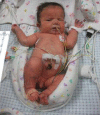Severe congenital thrombocytopaenia--first clinical manifestation of Noonan syndrome
- PMID: 22605701
- PMCID: PMC3316823
- DOI: 10.1136/bcr.10.2011.4940
Severe congenital thrombocytopaenia--first clinical manifestation of Noonan syndrome
Abstract
This report focuses on a male infant, the first born of non-consanguineous parents diagnosed with polyhydramnios at 26 weeks of gestation. The newborn was admitted during the neonatal period with bleeding diathesis associated with a low platelet count at birth (5×10(9)/l).The authors registered a persistent low platelet count (9000-129 000/l) during the infants 1st year of life. Physical examination revealed a petechial rash, a dysmorphic face and bilateral cryptorchidism, in the absence of organomegaly. Additionally, cardiologic evaluation revealed an aortic valve dysplasia and an atrial septal defect, while bone marrow biopsy and aspiration were found normal. Throughout the investigation, the authors excluded congenital infection, alloimmune and familiar thrombocytopaenia, Fanconi anaemia and thrombocytopaenia absent radius syndrome. The cytogenetic analysis revealed a mutation in the PTPN11 gene associated with Noonan syndrome. Here the author highlights that severe neonatal thrombocytopaenia is a manifestation that should be considered in the diagnosis and clinical management of Noonan's syndrome.
Conflict of interest statement
Figures


References
-
- Bastida P, García-Miñaúr S, Ezquieta B, et al. Myeloproliferative disorder in Noonan syndrome. J Pediatr Hematol Oncol 2011;33:e43–5 - PubMed
-
- Derbent M, Öncel Y, Tokel K, et al. Clinical and hematologic findings in Noonan syndrome patients with PTPN11 gene mutations. Am J Med Genet A 2010;152A:2768–74 - PubMed
-
- Bader-Meunier B, Tchernia G, Miélot F, et al. Occurrence of myeloproliferative disorder in patients with Noonan syndrome. J Pediatr 1997;130:885–9 - PubMed
-
- Singer ST, Hurst D, Addiego JE., JrBleeding disorders in Noonan syndrome: three case reports and review of the literature. J Pediatr Hematol Oncol 1997;19:130–4 - PubMed
-
- Bertola DR, Carneiro JD, D’Amico EA, et al. Hematological findings in Noonan syndrome. Rev Hosp Clin Fac Med Sao Paulo 2003;58:5–8 - PubMed
Publication types
MeSH terms
LinkOut - more resources
Full Text Sources
Miscellaneous
